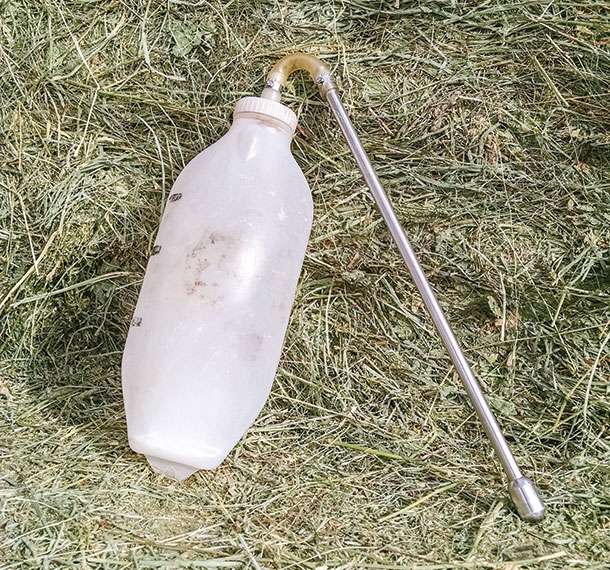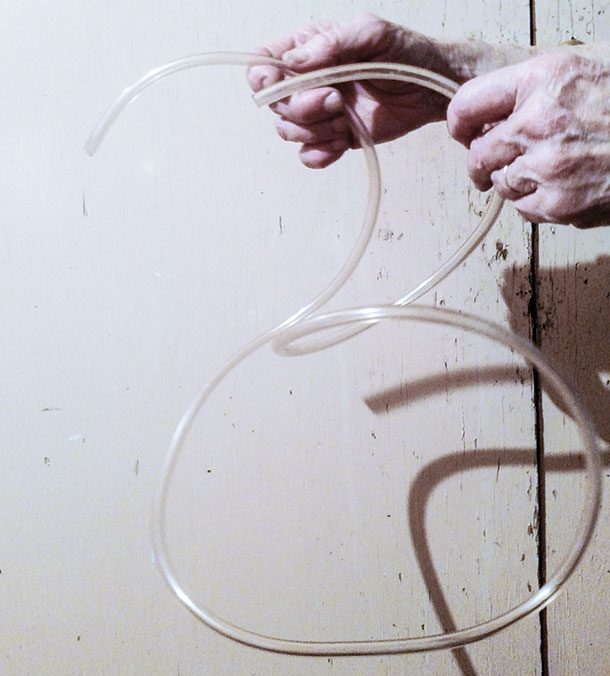Esophageal feeder
 This is a non-flexible plastic or stainless steel tube (about a half-inch in diameter) with a larger-diameter bulb on the end that goes down the calf’s throat.
This is a non-flexible plastic or stainless steel tube (about a half-inch in diameter) with a larger-diameter bulb on the end that goes down the calf’s throat.
A container for milk/fluid is attached to the other end. Some have a valve that keeps the fluid from entering the tube until you release it. Others have a bag/bottle that hangs down until you raise it to allow fluid to go into the tube.
The rounded bulb on the end of the probe protects the mouth and throat from being scraped or punctured and helps prevent backflow of fluids up the esophagus, acting as a plug.
It also helps the tube bypass the larynx and small opening into the windpipe. The windpipe is slightly below and alongside the esophagus, explains Dr. Shelie Laflin, who was clinical associate professor of agricultural practices at Kansas State University until she went back to the family ranch near Olsburg, Kansas, in January 2015.
There are several kinds of feeder probes, but they all have a flexible connection between rod and bag. “When you pass the tube, it is important to keep that connector kinked off.
You don’t want the fluid to go down the tube before you know it is in the right place,” she explains.
“When working by yourself, the probes attached to a bag instead of a bottle are easier to handle because you can hang the bag on a fence, stall wall or grill of your pickup and have your hands free.
The ones with a bottle, you have to juggle it all by yourself and it can be more difficult,” says Laflin.
“When using an esophageal feeder on bigger calves, giving fluids to treat scours, versus colostrum to a newborn, I prefer metal tubes.
The plastic ones are not as durable, and if you aren’t careful, bigger calves can grab it with their molars, bite it in two and swallow the end of it,” she says.
It helps if the calf is standing, backed into a corner against a fence or your pickup. If you straddle his neck and hold it between your legs, he cannot wiggle around much. It’s easier to administer fluids/colostrum to a standing calf than one lying down.
“Keep his head and neck straight. Slowly and gently pass the tube. Never force it or you can damage the pharyngeal area in the back of the throat. Once I get it started, I reach along the outside of his neck/throat and feel for that bulb to pass,” Laflin says.
“If you tuck the trachea between your fingers, you should be in the jugular groove and can feel the bulb as it passes into the esophagus.” The windpipe and the esophagus are next to each other, so make sure the bulb is going into the esophagus.
“People usually think the calf will cough/gag if the tube is in the wrong place, but they don’t always. I want to feel that bulb pass over the top of my fingers. If it doesn’t, I redirect it,” she explains.
Once you are sure it’s in the esophagus, tip up the bag or release the clamp to turn the fluid on. “If it slows or stops, move the tube 1 or 2 inches farther in or out, and it usually flows again.
Sometimes the esophagus will press against it and seal off the end, especially when giving thick colostrum or some of the scour packets that contain psyllium and become very thick,” explains Laflin.
“After all the fluid has gone down the tube, kink the connecter again so nothing else goes down as you are pulling the tube out.
You don’t want any fluid dripping from the tube.” If it happened to get into the windpipe, it could go down into the lungs and cause pneumonia.
Using a nasogastric tube
This flexible tube goes into the nostril to the back of the throat, into the esophagus – then down into the stomach. For calves, a tube 4 feet long is adequate, about a quarter-inch in diameter.
 For adult cattle, you need a tube, about a half-inch to three-quarter-inch diameter, at least 7 feet long.
For adult cattle, you need a tube, about a half-inch to three-quarter-inch diameter, at least 7 feet long.
A nasogastric tube is handy to administer fluids and is better than an esophageal feeder when treating a bloated animal; it goes clear into the rumen to let gas come back out before you pour in mineral oil or other medications, according to Lynn Thomas, a rancher in eastern Idaho who has been using nasogastric tubes since 1969.
The tube is also useful if a calf is plugged up from eating dirt. You can put a small amount of water directly into the stomach and let it come back out the tube, bringing dirt with it.
By alternately putting water in and draining it out, you can clean dirt out of a calf.
You can make a nasogastric tube from any flexible tubing of proper diameter. Smooth one end with a knife, sander or grinder so it won’t scrape the nasal passage and throat. “With a brand-new tube, smooth the end that you’ll be putting into the calf,” says Laflin.
Administer fluid by attaching a funnel to your end after the smooth end has been put into the stomach via the nostril. To administer mineral oil or castor oil (the latter is thick and won’t run down the tube), Thomas uses a 140-cc syringe to force warm oil mixed with a little warm water down the tube.
Backing the calf into a corner, hold his head/neck between your legs. Tuck his nose down toward his chest before inserting the tube.
If his head is up or stretched forward, the tube will go straight into the windpipe instead of the esophagus. The esophagus is slightly above the windpipe. “If you can flex his head/neck a little, it helps direct the tube into the esophagus,” explains Laflin.
Put the smooth end into one nostril quickly – before the calf sees it coming and resists by clamping the inner part of his nostril (which calves do if they’ve been “tubed” before).
“If he clamps it shut, it’s hard to insert the tube and may bloody his nose,” says Thomas. Push the tube quickly into the nostril to the back of the throat, then go gently and slowly so the calf can swallow it. He must swallow the tube before it can enter the esophagus. If he doesn’t swallow, it will go into his windpipe instead.
“If you suck on your end as you insert the tube and it’s partway down, if you get negative pressure (sucking with nothing coming out), this means it’s in the esophagus, which is not as rigid as the trachea and collapses/closes around the end of the tube,” says Laflin. By contrast, if you get air back when you suck on your end, it’s in the trachea. Take it out and start over.
Don’t administer fluid, oil or colostrum until you’re sure it’s in the right place or you risk drowning the calf. If he coughs as you try to put in the tube, this usually means it’s in his windpipe.
“If it goes down easily, with no resistance – and goes in at least 2 feet or more in a small calf – it’s in the stomach,” says Thomas. It can’t get that far in the windpipe because the trachea branches into smaller bronchial tubes.
Once the tube is in far enough on an older calf with a functional rumen (not newborn), you can check to make sure it’s in the stomach by blowing on your end. “If you hear burbling or smell stomach gas coming out, it’s in the stomach,” he says.
If your blowing makes the calf cough, it’s probably in the windpipe and you must take it out.
Once you’re sure it’s in the stomach, attach a funnel and administer the fluid or colostrum, or use a syringe to force down mineral oil or castor oil if you’re treating bloat, a plugged-up calf or a calf with acute toxic gut infection that shut down the gut. ![]()
Heather Thomas is a freelance writer based in Idaho.
PHOTOS
PHOTO 1: Inserting a nasogastric tube will help direct fluids directly into the rumen.
PHOTO 2: An esophageal probe/drench.
PHOTO 3: A closer look at nasogastric tubes. Photos courtesy of Heather Thomas.







